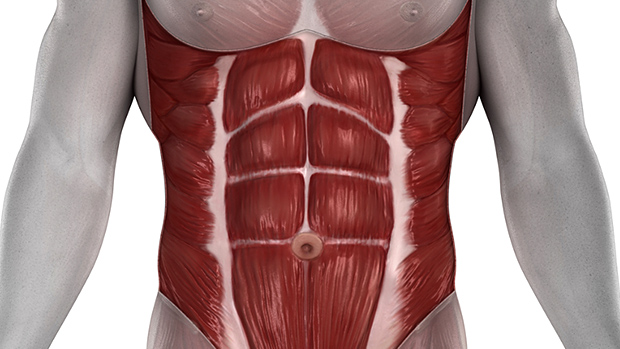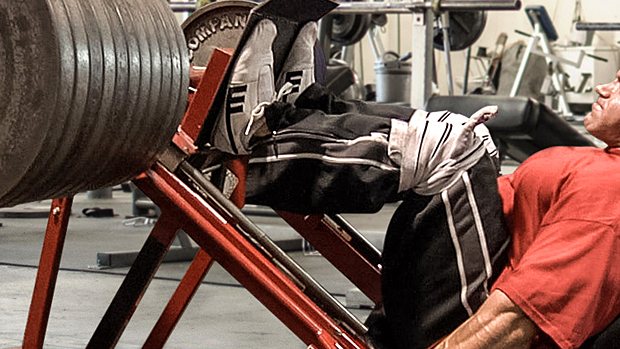Here's what you need to know...
- The rate of shoulder injuries rises with excessive reps, excessive machine use, and often bodybuilding-style programming.
- Lower back injuries increase when flexing or extending the lower back under heavy loads. Keep the spine neutral.
- Knee injuries are high when the knees don't track properly throughout the lifts. Keep the knees from collapsing inward if you want them to be healthy.
- Upper back and neck injuries occur with poor posture. Fix a hunched over back to prevent cervical spine injuries.
Not inherently at least. And not compared to a number of other types of athletic endeavors.
Resistance training is actually pretty safe. What makes lifting unsafe are the missteps, and sometimes just plain idiocy, many individuals bring to the practice.
From bastardizing technique and butchering form to pumping ego instead of muscles, some people have given weight training a black eye.
If lifting is dangerous in the eyes of the ignorant, we better figure out what exactly "lifting" entails so we can be sure to keep these lifting-phobes a safe distance from the squat rack, bench press, and other physically catastrophic environments.
We can break lifting down into four major categories:
- Traditional weight training – bodybuilding
- The sport of lifting weights – powerlifting, Olympic lifting
- Sport performance training – athletics
- Crosstraining – classes and boot camps
There's more, but these are the major players.

The cervical spine – upper back and neck – is most notably vulnerable to injuries in both the soft tissue and joint structures such as the discs and ligaments due to heavy bracing techniques, poor spinal posture and loads of ugly repeated flexion and extension movements.
Soreness and joint stiffness due to bracing in a neutral cervical position under heavy loading is part of the iron game, but flailing your head around and putting undue stresses on intricate body structures is just plain stupid.
If you don't know what I'm referring to, just think of turning the dumbbell shrug movement into a mosh pit at a Slip Knot concert. Don't be that guy.
The most innocent of all just may be transferring poor spinal posture from your daily sedentary life into the gym and not realizing you're putting yourself at risk.
The average American has a forward head posture which causes hyperextension of the upper segments of the cervical spine, and lower segmental flexion. That's a recipe for a nasty neck tweak on your next squat or deadlift if not corrected.
Prevent It
Fix your posture. Get a neutral spine. For the cervical spine, I can't think of a single position that is of more importance than the braced and neutral neck position.
Drive your chin directly backwards towards your spine and create a slight downward gaze with your eyes. This position holds true for every single movement, no matter if it's upper body or lower body specific.

Most assume the knee is highly injurious. There is some truth to this joint being more vulnerable than others due to its anatomical properties and orientation relative to the ankle and hip complexes.
But there's more to the story.
First, the structure of the knee joint is very immobile by nature, as it is a hinge joint with only two true degrees of freedom, meaning it only moves into flexion and extension.
Less relative motion from the knee in combination with poor gross movement through joints that are supposed to be highly mobile – like the many synergistic joints of the ankle complex in addition to the ball and socket type hip joint – put undue stress over non-contractile tissues like ligaments and cartilage.
This kink in the kinetic chain is most notable for lifters in quad-dominant movements like squat and lunge variations.
While global instability of the knee joint may be a chicken-or-the-egg argument with the co-morbid factors like stiff and immobile joints above and below the level of the knee, many chronic natured injuries also become symptomatic over the front side of the knee at the patella.
Increased tone and tightness through the quads can increase compressional and shear forces through the kneecap, causing increased rates of patella-femoral friction and irritation.
Functionally shortened and stiff quads in combination with poor patellar movement is exacerbated with poor squat mechanics such as anteriorly drifting knees and valgus drop, and also in lunge-type movements when the knee joint is forced into terminal flexion.
If this sounds like a pretty big problem that most lifters need to address, it is. Pay attention, this simple cue below can clean up your movement and give those pissed-off knees just enough of a break to recover for good.
Prevent It
Pay attention to knee tracking. There are loads of different lower body movements that involve both the squat and lunge variations.
Though each movement is unique and has many important factors to execute crisp, clean reps, starting off with an appreciation for where your knee should be positioned relative to your foot can clean up even the most pitiful form pretty quickly.
When reaching the bottom position for both the squat and lunge, the patella should be tracking over the lateral aspect of the foot.
Some coaches teach these movements with the knee directly over the midline of the foot, but I have seen this cue fall apart in terms of mechanics of motion many times.
By targeting the midline of your kneecap to track directly over your pinkie toe, the glutes and hamstrings are able to be targeted with just enough torque and spiral tension loading that the unwanted valgus collapse and anterior knee translation is minimized almost automatically.

Though lower back pain affects nearly 80% of people every single year to some extent, a majority of lifters just aren't putting themselves in harm's way in terms of lower back dysfunction.
Sure, if you're a high level athlete that really straddles the line between optimal performance and potential injury there may be an argument that lower back pain and injury is the most prevalent in all of lifting. But from the research and thousands of living and breathing case studies, the numbers just don't match up.
The last time you trained at a commercial gym, were there more people on machines, or in the squat rack, or pulling weights from the floor?
Probably the machines. There are three to four squat racks at best in the commercial gym setting and pulling from the floor is near impossible due to the strategically engineered octagonal plates that will leave you with bruised shins before you pull a PR.
As for the high level athletics, there are a couple of interesting findings when it comes to the sports of powerlifting and CrossFit.
For the most part, recent research has shown CrossFit to be pretty back-friendly, except where powerlifting movements are concerned. Throughout the other specialties in CrossFit, such as endurance and Olympic lifting, lower back injuries are nearly non-existent.
Prevent It
Keep a neutral spine. Awareness of your spine's position is crucial to keeping it neutral when challenged with heavier loads, more demanding metabolic environments, or just reacting and correcting a lift that starts to lose form quick.
For the general purpose of lifting and weight training, there are three main lumbar spine positions to define: flexion, extension, and neutral.
Flexion through the lower spinal segments can be injurious, especially as other factors such as load, speed, and articulations of other joints come into play.
What most people don't realize is that excessive extension of the lower spine can also be equally as shitty in terms of injury prevention.
Don't flex or extend excessively when lifting. Use a semi-neutral spinal posture.
A neutral spine, through not perfectly straight, can be achieved by bracing your lumbo-pelvic stabilizers like the four layers of abdominal musculature and other surrounding structures and closing down the distance between the pubic bone and the bottom of the sternum.
The maintenance of this position will play a key role in not only protecting the back, but cleaning up your lifting form as well.

Bodybuilding-style training has carved its way into the general lifting population for the greater portion of the last two decades.
Many machines can be useful, but chronic adherence to movements that have no need for requisite shoulder stability or position to perform can be a slippery slope for joint and soft tissue health.
Another big issue is determining the correct settings to place (sometimes overly) complicated machines on to create force planes that target the muscles, not non-contractile tissues like the tendons, ligaments and joints.
How about all those pretend choreographed lifting classes with the 10-pound barbell and four pound weights? That still counts as lifting. Love it or hate it, this is where a majority of people find themselves in the landscape of fitness.
Want to know a good way to ensure that you end up with a painfully dysfunctional shoulder that will keep you up at night with the kind of deep aches that may warrant a trip to the radiologist?
Do one of those pump classes containing 1,000 reps of dumbbell curls, followed by another 2,000 reps of overhead presses without any hope of keeping tight form or challenging muscles.
Follow that scenario up with heavy planking in heavy internally rotated shoulder positions, and there you have it, you're shoulders will be wrecked in no time.
Prevent It
Create spiral tension and torqued setup.
Not sure what that means? For all loaded movements, machines, free weights, barbells and kettlebells alike, there needs to be an emphasis placed not only on movement execution, but also optimal setup to ensure proper positioning and stability before a movement even begins.
The upper extremity is one of the most reactive regions of the body for creating functional spiraling and torque throughout its joints and tissues, thus leading to a highly centerated shoulder position capable of high performance and safety.
From the bench press to the machine press, pull-up to row machine, this same spiral loading mechanism can play a huge role in learning neutral positions of the shoulder that create a foundational setup to work off of once the movement begins.
The first step is finding this position and getting an appreciation for it. From there, maintenance throughout sets in different actions and planes of motion will ensure that you won't be falling victim to a largely preventable shoulder injury down the road.

- Raske A, Norlin R. Injury Incidence and Prevalence Among Elite Weight and Power Lifters. Am J Sports Med. 2002 Mar-Apr;30(2):248-56.
- Calhoon G, Fry A. Injury Rates and Profiles of Elite Competitive Weightlifters. J Athl Train. 1999 Jul-Sep;34(3):232-238.
- Hamil P. Relative Safety of Weightlifting and Weight Training. J Strength Cond Res. 1994 Feb;8(1).
- Siewe J, Marx G, et al. Injuries and Overuse Syndromes in Competitive and Elite Bodybuilding. Int J Sports Med. 2014 Oct;35(11):943-8.
- Siewe J, Rudat J, et al. Injuries and Overuse Syndromes in Powerlifting. Int J Sports Med. 2011 Sep;32(9):703-11.
- Weitz B. Minimizing Weight Training Injuries in Bodybuilders and Athletes. Topics in Clinical Chiropractic. 1997;4(2):46-56.
- Keogh J, Hume PA, Pearson S. Retrospective Injury Epidemiology of One Hundred One Competitive Power Lifters: the Effects of Age, Body Mass, Competitive Standard, and Gender. J Strength Cond Res. 2006 Aug;20(3):672-81.
- Hak P, Hodzovic E, et al. The Nature and Prevalence of Injury During CrossFit Training. J Strength Cond Res. 2013 Nov 22. [Epub ahead of print].
- Weisenthal BM, Beck CA et al. Injury Rate and Patterns Among CrossFit Athletes. Orthopaedic Journal of Sports Medicine. 2014 2.





